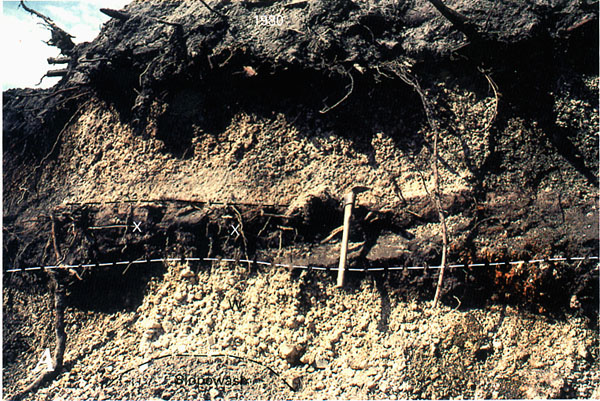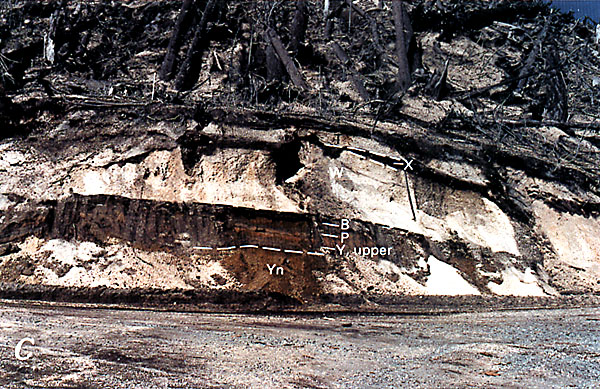
Figure 6

Figure 6A. Field characteristics of tephra units, Mount St. Helens. A, Road cutbank about 10 km northeast of the volcano. Coarse grain size and white color of the lower unit shown identify tephra set W, which here consists almost entirely of layer Wn. Tephra set W is overlain by the dark, fine-grained set X, and in turn by the light-gray to brown, coarse-grained layer T. The brown color of layer T results from iron staining in a surficial soil zone. Dark-gray ejecta from the 1980 eruptions lie at the top of the outcrop. Fine-grained set X here forms a slight ledge in this outcrop. The ledge causes small particles of layer T and the 1980 deposits to cover the base of layer T, which is not finer in its lower part as the photograph might suggest. Small pick shown for scale. Photograph taken 1982.
Figure 6B. Outcrop above quarry, at 9 km bearing 055 degrees from the volcano. Tephra set S overlies
glacial drift; tephra set S consists of coarse, pale layers Sg and So overlying ash-size deposits. Set J is made
up here of one lapilli bed and is separated from set S by a thick, oxidized ash-rich deposit. Set Y consists of
lapilli-and-bomb layers Yb and Yn interbedded with ash. Set P is characterized by pale, thin layers; a flowage
deposit is interbedded with the tephra here. Set B is relatively dark and also is characterized by thin layers.
Set W, about 100 cm thick, consists chiefly of lapilli and bombs of layer Wn at this site. Photograph taken in
1970.

Figure 6C. Road cutbank about 14 km northeast of the volcano. Roadcut exposures over a wide area northeast of Mount St. Helens show distinct pale bands of pumice lapilli separated by darker bands of chiefly ash. Here, pale layer T lapilli are underlain by the dark band of set X, which separates the layer from the coarse, pale set W (mostly layer Wn). Tephra set W is about 125 cm thick here. Sets B and P and the upper part of set Y form a dark ash stratum below set W. In a fresher exposure, layer Yn in the lower part of set Y would be seen as another stratum of pale lapilli (see Fig. 34). Photograph taken in 1983.